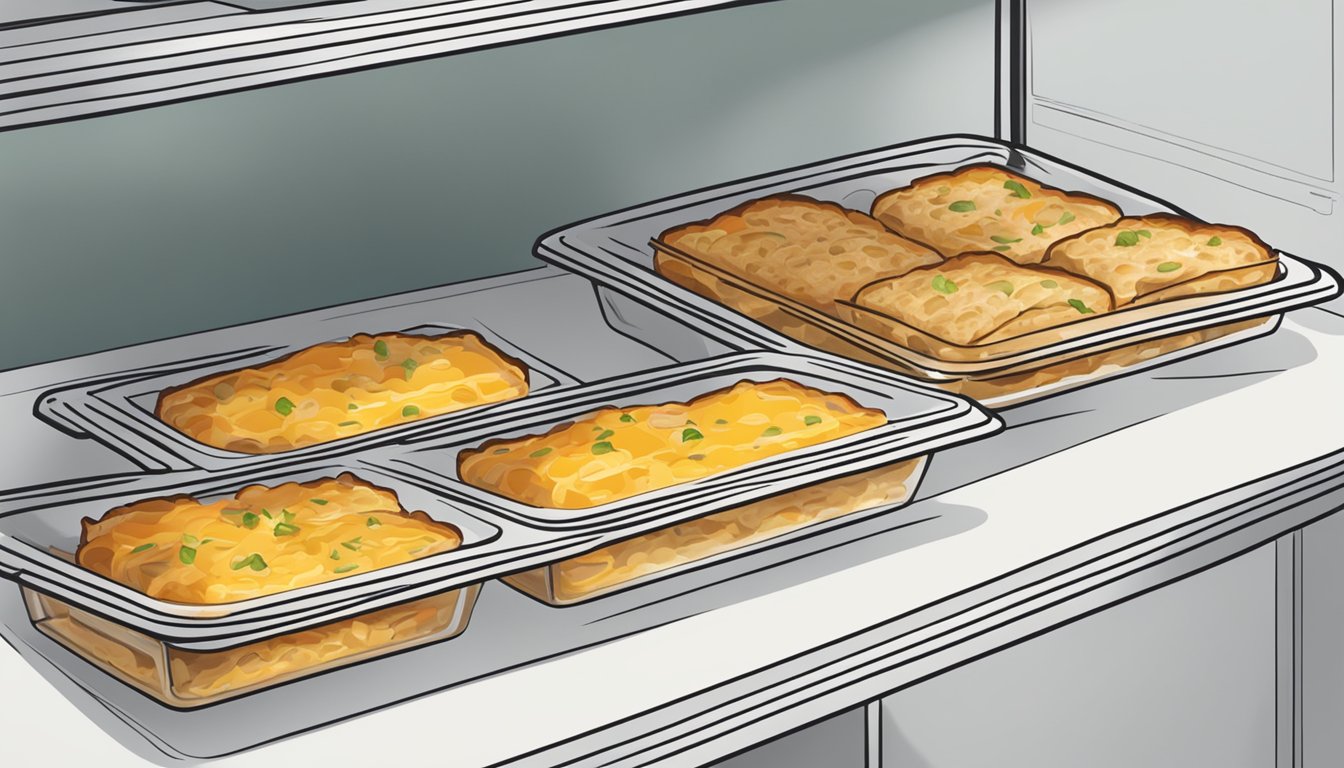Breakfast casseroles are a beloved staple for many families, offering a convenient way to enjoy a hearty meal in the morning. These versatile dishes can be prepared ahead of time, making them perfect for busy households or special occasions. Breakfast casseroles can indeed be frozen, allowing for even more convenience and meal planning flexibility.
Freezing a homemade breakfast casserole is a simple process that can save time and reduce food waste. By preparing a large batch and freezing portions, one can have a delicious breakfast ready to heat and serve on busy mornings. This method works well for both savory and sweet breakfast casseroles, accommodating various dietary preferences and ingredients.
When freezing a breakfast casserole, proper storage techniques are crucial to maintain quality and prevent freezer burn. Wrapping the casserole tightly in plastic wrap and aluminum foil before placing it in a freezer-safe container helps preserve its flavor and texture for up to three months. Thawing the casserole overnight in the refrigerator ensures even reheating and optimal taste when served.
Basics of Breakfast Casseroles

Breakfast casseroles combine savory ingredients with eggs to create hearty, satisfying meals. These versatile dishes can be customized with various proteins, vegetables, and cheeses.
Common Ingredients
Eggs form the foundation of most breakfast casseroles, providing structure and protein. Shredded cheese adds flavor and richness, with cheddar and mozzarella being popular choices. Hash browns or cubed bread often serve as the starchy base.
Proteins like turkey sausage, bacon, or ham contribute savory notes. Vegetables such as bell peppers and onions add color and nutrition. Some recipes incorporate sweet potatoes for a healthier twist.
Milk or cream is typically mixed with the eggs to create a custard-like consistency. Salt, pepper, and herbs season the dish.
Building Flavors
Layering ingredients strategically enhances the taste and texture of breakfast casseroles. Start with a layer of hash browns or bread cubes at the bottom of the baking dish. This absorbs excess moisture and prevents a soggy casserole.
Next, add a layer of cooked proteins and sautéed vegetables. This ensures even distribution throughout the dish. Pour the egg mixture over the layers, allowing it to seep into all the crevices.
Top with shredded cheese for a golden, crispy crust. Experiment with flavor combinations like spinach and feta or mushroom and Swiss. Fresh herbs like chives or parsley can be sprinkled on top before baking for a burst of freshness.
Benefits of Freezing Breakfast Casseroles

Freezing breakfast casseroles offers several advantages for home cooks and busy families. This method enhances meal planning efficiency, reduces food waste, and preserves nutritional content.
Meal Prep Convenience
Freezing breakfast casseroles streamlines morning routines. Preparing multiple casseroles at once allows for easy batch cooking. Portioned servings can be frozen individually, providing grab-and-go options.
Thawing and reheating frozen casseroles is simple. Place them in the refrigerator overnight or use the microwave for quick defrosting. This saves time during hectic mornings.
Pre-made frozen casseroles are ideal for unexpected guests or busy weekends. Having a ready-made meal on hand reduces stress and eliminates last-minute cooking.
Reducing Food Waste
Freezing breakfast casseroles helps minimize food waste. Leftover ingredients can be incorporated into casseroles and frozen for later use. This practice prevents spoilage of perishable items.
Bulk purchases become more practical when freezing is an option. Larger quantities of ingredients can be used efficiently without risk of waste. Seasonal produce can be preserved in casseroles, extending its usefulness beyond peak availability.
Portioning casseroles before freezing allows for precise serving sizes. This reduces the likelihood of leftovers going to waste after reheating.
Maintaining Nutritional Value
Proper freezing techniques help preserve the nutritional content of breakfast casseroles. Quick freezing at low temperatures maintains vitamin and mineral levels.
Frozen casseroles retain their protein content effectively. Eggs, cheese, and meat components remain stable during freezing. Fiber from vegetables and whole grains is also well-preserved.
Frozen casseroles can be fortified with additional nutrients before freezing. Adding extra vegetables or using nutrient-dense ingredients enhances the overall nutritional profile. This method ensures a balanced meal even after storage.
Proper Freezing Techniques
Freezing breakfast casseroles correctly preserves their flavor and texture. Using the right methods ensures your dish stays delicious when thawed and reheated.
Preparing for the Freezer
Cool the casserole completely before freezing. This prevents ice crystals from forming and damaging the texture. Divide large casseroles into smaller portions for easier thawing and reheating. Wrap the casserole tightly in plastic wrap, pressing out any air pockets. For added protection, cover with a layer of aluminum foil.
Label each package with the contents and date. Include reheating instructions for convenience. Place the wrapped casserole on a flat surface in the freezer until solid. This prevents the casserole from conforming to the shape of other items in the freezer.
Preventing Freezer Burn
Freezer burn occurs when air reaches the food’s surface, causing dehydration and oxidation. To prevent this, remove as much air as possible when wrapping the casserole. Double-wrapping provides an extra barrier against air exposure.
For long-term storage, consider vacuum sealing. This method removes all air, significantly extending the casserole’s freezer life. Store the casserole in the coldest part of the freezer, typically the back. Maintain a consistent freezer temperature of 0°F (-18°C) or below.
Freezer-Safe Containers
Choose containers that are specifically designed for freezer use. Glass, plastic, and aluminum foil pans are all suitable options. Glass containers are durable and don’t absorb odors, but can crack if thermal shocked. Plastic containers are lightweight and stackable, but may absorb odors over time.
Disposable aluminum foil pans are convenient for baking and freezing in the same container. Ensure containers have tight-fitting lids to prevent air exposure. Leave about an inch of headspace in the container to allow for expansion as the casserole freezes.
Avoid using containers with cracks or damage, as these can allow air to enter. For added protection, wrap the entire container in plastic wrap or aluminum foil before freezing.
Thawing and Reheating Methods
Properly thawing and reheating a frozen breakfast casserole ensures food safety and optimal taste. The most effective methods preserve texture while heating the dish evenly throughout.
Thaw Overnight
Place the frozen casserole in the refrigerator 24 hours before serving. This slow thawing process prevents bacterial growth and maintains food quality.
Remove any plastic wrap or foil before refrigerating. Use an airtight container or cover with fresh wrap to prevent contamination.
For best results, transfer the casserole to a clean baking dish after thawing. This promotes even heating during reheating.
Safe Reheating Instructions
Preheat the oven to 350°F (175°C). Cover the thawed casserole with foil to retain moisture.
Bake for 30-45 minutes until the internal temperature reaches 165°F (74°C). Use a food thermometer to check.
For faster reheating, cut the casserole into portions before baking. Small sections heat more quickly and evenly.
Avoid microwaving, as it can lead to uneven heating and rubbery eggs. If necessary, microwave individual portions for 1-2 minutes, stirring halfway through.
Casserole Variations

Breakfast casseroles offer endless possibilities for customization. From hearty meat-filled options to veggie-packed dishes, there’s a variation to suit every taste and dietary preference.
Vegetarian Options
Vegetarian breakfast casseroles can be just as satisfying as their meaty counterparts. Hashbrown casseroles are a popular choice, combining crispy potatoes with eggs, cheese, and vegetables. Try adding bell peppers, spinach, and mushrooms for extra nutrition and flavor.
For a protein boost, incorporate cubed tofu or plant-based sausage alternatives. Broccoli and cheddar make a classic pairing, while sun-dried tomatoes and feta offer a Mediterranean twist.
Don’t forget about sweet options. A french toast casserole with berries and nuts can be prepped the night before and baked in the morning for a delicious start to the day.
Meat Lover’s Choices
Meat enthusiasts have plenty of options for protein-packed breakfast casseroles. Sausage and bacon are classic additions that add smoky flavor and richness to any dish.
Ham and cheese casseroles are another favorite, often combined with cubed bread or hashbrowns for a hearty meal. For a Tex-Mex twist, try a chorizo and egg casserole with black beans and corn.
Leftover rotisserie chicken can be repurposed into a tasty breakfast bake with spinach and feta. For a luxurious option, consider adding smoked salmon and dill to an egg and cream cheese base.
Handling Leftovers
Proper management of leftover breakfast casserole ensures food safety and quality. Refreezing guidelines and tracking storage time are crucial aspects to consider when dealing with excess portions.
Refreezing Guidelines
Refreezing breakfast casserole is possible, but certain precautions should be taken. If the casserole has been thawed in the refrigerator and not heated, it can be safely refrozen within 3-4 days. However, refreezing after reheating is not recommended, as it may compromise food safety and texture.
For best results, divide leftovers into single-serving portions before refreezing. This allows for easier thawing and reheating of smaller amounts as needed. Use airtight containers or freezer bags to prevent freezer burn and maintain quality.
Keeping Track of Storage Time
Labeling containers with the date of freezing is essential for tracking storage time. Frozen breakfast casserole remains safe indefinitely, but quality declines over time. For optimal taste and texture, consume within 2-3 months of freezing.
Use a first-in, first-out system to ensure older portions are used before newer ones. Keep a list of frozen items on the freezer door or in a meal planning app to stay organized.
When using frozen leftovers, check for signs of freezer burn or off-odors before consuming. If in doubt about the storage duration or quality, it’s best to discard the casserole to avoid potential foodborne illness.
Creating Your Own Breakfast Casserole

Making a breakfast casserole is simple and versatile. You can customize ingredients to suit your tastes and dietary needs while preparing a satisfying meal for multiple servings.
Easy Breakfast Casserole Recipe
Start with a basic recipe as your foundation. Beat 6 eggs in a large bowl. Add 2 cups of milk, 1 cup of shredded cheese, and 1 teaspoon of salt. Mix well.
Grease a 9×13 inch baking dish. Layer 6 slices of bread, torn into pieces, in the bottom. Pour the egg mixture over the bread.
Add 1 pound of cooked breakfast sausage or bacon. Sprinkle additional cheese on top if desired. Cover and refrigerate overnight.
Bake at 350°F for 45-50 minutes until set and golden brown.
Customizable Ingredients
Adapt your casserole to personal preferences. Swap bread for hash browns or tater tots for a different texture. Use various cheeses like cheddar, Swiss, or feta for unique flavors.
Add vegetables such as bell peppers, onions, or spinach for extra nutrition. Try ham, turkey, or vegetarian sausage instead of traditional pork products.
For a sweeter option, use cinnamon raisin bread and add diced apples or berries. Experiment with herbs and spices like thyme, basil, or paprika to enhance the taste.
Consider dietary restrictions by using non-dairy milk alternatives or gluten-free bread options.
Tips and Tricks

Freezing breakfast casseroles can be a game-changer for busy mornings. These tips will help you achieve optimal results when preparing, freezing, and reheating your homemade breakfast favorites.
Optimizing Cooking Time
Slightly undercook the casserole before freezing. This prevents overcooking when reheating and ensures a better texture. Cook eggs until just set and leave potatoes slightly firm.
Use oven-safe, freezer-safe containers for easy reheating. Glass or ceramic dishes work well, but disposable aluminum pans are convenient for gifting or storing multiple casseroles.
Portion the casserole into individual servings before freezing. This allows for quicker thawing and reheating times, perfect for single servings or smaller households.
Enhancing Taste and Texture
Let the casserole cool completely before freezing. This prevents ice crystals from forming and helps maintain the dish’s texture.
Wrap the cooled casserole tightly in plastic wrap, then aluminum foil. This double layer prevents freezer burn and preserves flavor.
Add toppings like cheese or breadcrumbs after thawing and reheating. This ensures crispy textures and fresh flavors.
Use ingredients that freeze well, such as hearty vegetables and cooked meats. Avoid high-water content vegetables like tomatoes or zucchini, which can become mushy.




